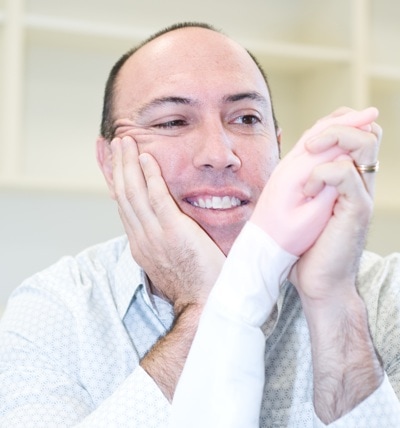The gate control theory gave us all a theoretical rationale for ‘rubbing it better’ – activation of Aβ fibres and subsequent ‘closing of the gate’ in the dorsal horn. Well, there is a new paper just out in Pain,[1] that raises the possibility of another quick and easy analgesic strategy – crossing your arms. My mum reckons that her mum was onto that decades ago – perhaps we have uncovered a mechanism behind an age-old trick. Regardless, here is what we did: There were two experiments – the first was a behavioural experiment, which means that participants just reported what happened for them in response to a series of stimuli. The second was a physiological experiment in which electrical responses to the stimuli were recorded through electrodes placed over the scalp. The experimental design was more or less the same for both – two postural conditions: arms in front and uncrossed versus arms in front and crossed over one another – and several stimulus conditions – noxious laser stimuli at different intensities and non-noxious electrical stimuli at different intensities.
Are you thinking to yourself, ‘Why do this experiment?’ Well, the theoretical background to it lies in a bunch of research that very strongly suggests that, when we determine the location of a somatosensory stimulus, we integrate its somatotopically-organised coordinates with its spatially-organised coordinates. That is, the brain allocates a location on the surface of the skin, using somatotopically organized maps such as that represented in primary sensory cortex. This information is then integrated with the location of the stimulus in space, relative to the body midline (to learn more about this stuff, buy Charlie Spence’s book. Actually, buying it will not help you learn more about this stuff – you would have to both buy it and read it). The critical bit is this: it is this integration of somatotopic and spatial frames of reference that is essential for awareness of the stimulus, for the actual production of a conscious experience. This raises the tantalizing possibility that if we put the somatotopic frame of reference into conflict with the spatial frame of reference, we might be able to impair the brain’s ability to create the perception. So that is what we did. By crossing the arms.
In case you hadn’t noticed, your left hand spends almost all of its time on the left side of your body and your right hand spends its time on the right side of your body. If our theory is correct, then crossing the arms presents an unusual and conflicting situation, because now the right hand is on the left and the left is on the right. Right?
Well, in the first experiment, our prediction was supported: exactly the same stimuli in each domain – noxious or non-noxious – evoked less intense perceptual experiences if the arms were crossed than if they were not. The difference was pretty small, but as we argued to the journal that published it, PAIN, the important thing here is that an effect occurs at all. This is the beginning, not the clinical application end. The second experiment investigated the brain’s processing of information. If it is indeed a disruption of the integration of somatotopic and spatial frames of reference that underpins the effect, rather than a change in the sensory signal arriving at the brain, then we should see a change in a late stage of the brain-evoked signal, not an early stage (a shift in the early stage would be more consistent with a change in S1 activation). Pleasingly, our prediction was again supported – there was a reduction in the late wave (N2 P2) but not the early wave (N1).
Who cares? Well, we do, obviously. We have targeted the very process by which pain emerges from the brain and showed that it is possible to reduce pain, simply by conflicting two frames of reference. This study opens up a new line of research to pursue better ways to do this. In the meantime, it seems that, when we hurt our hand, we should not only rub it better, but also cross it over.
About Lorimer Moseley
 Lorimer is NHMRC Senior Research Fellow with twenty years clinical experience working with people in pain. After spending some time as a Nuffield Medical Research Fellow at Oxford University he returned to Australia in 2009 to take up an NHMRC Senior Research Fellowship at Neuroscience Research Australia (NeuRA). In 2011, he was appointed Professor of Clinical Neurosciences & the Inaugural Chair in Physiotherapy at the University of South Australia, Adelaide. He runs the Body in Mind research groups. He is the only Clinical Scientist to have knocked over a water tank tower in Outback Australia.
Lorimer is NHMRC Senior Research Fellow with twenty years clinical experience working with people in pain. After spending some time as a Nuffield Medical Research Fellow at Oxford University he returned to Australia in 2009 to take up an NHMRC Senior Research Fellowship at Neuroscience Research Australia (NeuRA). In 2011, he was appointed Professor of Clinical Neurosciences & the Inaugural Chair in Physiotherapy at the University of South Australia, Adelaide. He runs the Body in Mind research groups. He is the only Clinical Scientist to have knocked over a water tank tower in Outback Australia.
Reference
[1]Gallace A, Torta DM, Moseley GL, & Iannetti GD (2011). The analgesic effect of crossing the arms. Pain, 152 (6), 1418-23 PMID: 21440992




